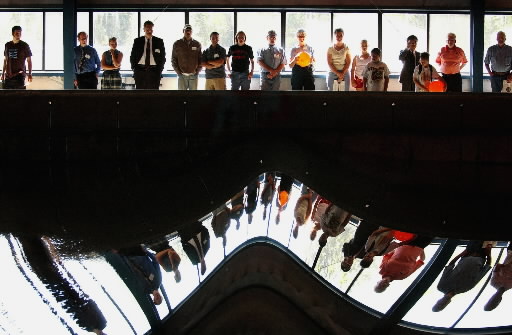World's Largest Tsunami Basin Makes a Big Splash At Oregon State University
By Gregg Kleiner, Oregon State University (541-737-9684)
CORVALLIS, Ore. - Researchers at the College of Engineering at Oregon State University are making some very big waves - literally. And in the process they plan to help safeguard towns and cities on the Earth's coastlines from killer tsunami waves that are triggered by underwater earthquakes.
In what is now the largest - and most-wired - tsunami laboratory anywhere in the world, OSU engineering researchers launched the biggest human-generated wave of its kind on Saturday, September 13 during a 10:30 a.m. dedication ceremony of the Tsunami Wave Basin, located at OSU's O. H. Hinsdale Wave Research Laboratory on campus.
 Sol Neelman, The Oregonian
Sol Neelman, The Oregonian
Wave Watchers Spectators watch the ceremonial first wave created in the new Tsunami Wave Basin at Oregon State University in Corvallis, Ore. The installation, the largest and most-wired in the world, will be used by scientists worldwide to study wave patterns and help mitigate ocean hazards like tsunamis and beach erosion.
By combining the latest in information technology with earthquake engineering, the new facility will enable researchers anywhere in the world to participate remotely in real-time experiments conducted in the wave basin.
"It was OSU's ability to blend cutting-edge information technology (IT) with civil and ocean engineering that helped us secure the NSF funding for this project," said OSU computer science professor Cherri Pancake who heads up the IT component of the new facility. "The IT allows researchers and students anywhere in the world to observe experiments as they happen, use instant replay, or slow experiments down to study details that normally happen so fast they can't be observed. All it takes is a web browser."
In addition to tsunamis, the new wave basin will also help researcher better mitigate other natural coastal hazards such as beach erosion and flooding caused by rising sea level. Studies suggest that sea level could rise two to seven feet during the next century due to global warming.
The OSU facility can also be used to study the effects of boat wakes on coastlines like the Puget Sound, determine how waves at the mouths of rivers like the Columbia can be more safely negotiated by ships, and innovate more effective breakwater designs.
Because more than half of the U.S. population resides within 50 miles of the nation's coastlines, it is critical to have effective warning systems and emergency shelters in place when a tsunami is generated, researchers say. Although tsunamis move at the speed of a jetliner, there is often 30 minutes or longer before the waves generated in the open ocean hit land, offering a window of time to orchestrate evacuation.
"Ultimately, this new e-tsunami facility will save lives, which is a big part of what engineering is all about," said Ron Adams, dean of engineering at OSU. "This facility is an example of the type of research clusters we're building here in the College of Engineering - groups of creative people from many different disciplines working together to discover solutions to complex problems. This is the new wave of engineering - where collaboration creates a collective synergy."
The OSU Tsunami Wave Basin is one of 15 linked sites in nine U.S. state funded by the NSF as part of the George E. Brown, Jr. Network for Earthquake Engineering Simulation (NEES). The tsunami facility is the first NEES site in the nation to come online, and much of the IT developed by OSU computer scientists for the OSU site will be employed at the other 15 sites.
"Construction is barely complete, and already we're getting calls from a wide range of researchers, media, and other people interested in the capabilities of this new facility," said Dan Cox, OSU ocean engineering professor and director of the O. H. Hinsdale Wave Research Laboratory. "This has definitely put Oregon State University center stage in the world of tsunami research, and it's exciting that our research will make the world safer."
Speakers at the dedication ceremony included OSU's new president Ed Ray; John Brighton, head of the National Science Foundation's Engineering Directorate; Oregon state senator Frank Morse; Marta Brown, and others.
For more information about the Hinsdale Wave Research Lab, including K-12 outreach, educational tours of the facility, and a computer animated fly-through of the facility, visit the website: http://wave.oregonstate.edu/.